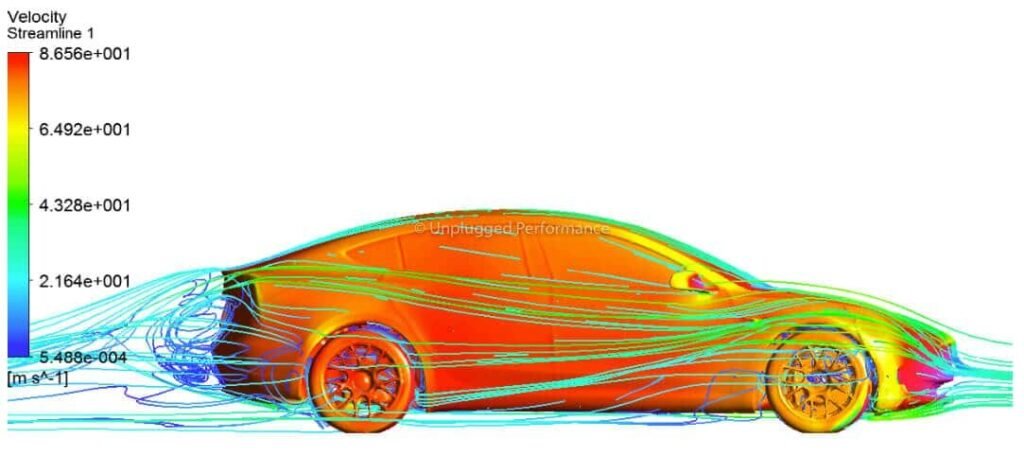Introduction

In the quest for fuel efficiency and performance, vehicle aerodynamics plays a pivotal role. It’s not just about sleek designs, but also the intricate engineering beneath the hood. In this article, we dive deep into the world of vehicle aerodynamics, exploring both external and under hood dynamics, and how they work together to enhance efficiency and performance.
External Aerodynamics: More than Meets the Eye
External aerodynamics is the study of how air interacts with the vehicle’s exterior surfaces. From the shape of the body to the positioning of mirrors, every element affects airflow. We’ll uncover the principles that govern external aerodynamics, including factors like drag, lift, and flow separation, and how they influence a vehicle’s performance and fuel economy.
Streamlining for Efficiency

Aerodynamic features like spoilers, air dams, and diffusers are strategically placed to optimize airflow around and beneath the vehicle. This section delves into how these elements reduce drag and enhance stability, resulting in improved fuel efficiency and better handling. We’ll also explore how wind tunnel testing and computational simulations refine these designs.
The Role of Underbody Aerodynamics
Underbody aerodynamics focuses on the flow of air beneath the vehicle. An aerodynamically optimized underbody reduces turbulence and lift, contributing to stability and handling. We’ll uncover the design principles that guide underbody features such as belly pans, flat floors, and diffusers, and their impact on a vehicle’s overall performance.
● Enhancing Vehicle Stability
● Ground Effect: Airflow Interaction between the Vehicle and Ground Surface
● Airflow Management: Reducing Turbulence and Lift for Improved Handling
● Diffusers: Shaping Airflow to Increase Downforce and Improve Aerodynamic Efficiency
● Belly Pans and Skid Plates: Smoothing the Underbody for Reduced Air Resistance
● Vortex Generators: Controlling Airflow to Enhance Stability and Performance
● Venturi Effect: Speeding up Airflow in Restricted Areas for Increased Downforce
● Wheel Arch Liners: Reducing Turbulence and Air Resistance around Wheel Wells
● CFD Simulations: Analyzing Underbody Aerodynamics for Optimal Design
● Integration with Front and Rear Aerodynamics: Achieving Coordinated Airflow Management.
Cooling Systems: Balancing Aerodynamics and Thermal Management
Under the hood, vehicles are equipped with complex cooling systems to regulate engine temperature. These systems, which include radiators, fans, and air ducts, must strike a delicate balance between aerodynamics and thermal management. This section explores how engineers optimize cooling systems to ensure efficient engine operation while maintaining aerodynamic efficiency.
● Dual Role of Cooling Systems: Regulating Component Temperatures and Minimizing Drag
● Aerodynamic Design: Streamlined Airflow Paths for Efficient Heat Dissipation
● Heat Exchangers: Radiators and Intercoolers for Effective Thermal Exchange
● Ducting and Air Guides: Directing Airflow to Enhance Cooling Efficiency
● Variable Cooling Systems: Adaptive Control for Optimal Temperature Regulation
● Radiator Grilles and Air Intakes: Design Elements to Balance Airflow and Cooling Needs
● Computational Fluid Dynamics (CFD): Simulating Airflow and Heat Transfer for Design Optimization
● Thermal Insulation: Protecting Surrounding Components from Heat Radiation
● Integration with Underbody Aerodynamics: Coordinated Airflow Management for Efficiency
● Wind Tunnel Testing: Experimental Validation of Cooling System Performance and Aerodynamics.
The Synergy between External and Under hood Aerodynamics
Achieving peak vehicle performance requires a harmonious integration of external and underhood aerodynamics. This section examines how these two facets work in tandem, demonstrating how innovations like active aerodynamics and adaptive cooling systems dynamically adjust to driving conditions, optimizing efficiency without compromising performance.
● External Aerodynamics: Optimizing Airflow around the Vehicle’s External Surfaces
● Underhood Aerodynamics: Managing Airflow within the Engine Compartment
● Mutual Influence: How External and Underhood Aerodynamics Impact Each Other
● Heat Dissipation: Coordinated Airflow to Cool Engine Components and Radiators
● Thermal Management: Balancing Engine Cooling Needs with Aerodynamic Efficiency
● Airflow Integration: Directing Underhood Airflow to Enhance External Aerodynamic Performance
● Intake and Exhaust Systems: Designing for Efficient Airflow Ingestion and Exhaust Gas Expulsion
● Combustion Air Intake: Coordinated Flow to Enhance Combustion Efficiency
● CFD Simulations: Analyzing Combined External and Underhood Aerodynamics for Design Optimization
● Real-world Testing: Validating the Synergistic Effects of External and Underhood Aerodynamics.
Future Frontiers: Advanced Materials and Computational Simulations
As automotive technology advances, so too do the possibilities for enhancing vehicle aerodynamics. Lightweight materials and advanced composites reduce weight and improve efficiency. Computational fluid dynamics (CFD) simulations allow engineers to refine designs virtually, accelerating the development process. We’ll take a glimpse into these cutting-edge technologies and their potential to shape the vehicles of tomorrow.
Conclusion: Engineering Efficiency for the Road Ahead
In the dynamic world of automotive engineering, vehicle aerodynamics external and underhood are critical factors that influence performance, efficiency, and sustainability. By optimizing external surfaces and underhood components, engineers are pushing the boundaries of what’s possible on the road. As we look to the future, continued advancements in aerodynamic design and technology promise to revolutionize the vehicles we drive, making them not only faster and more powerful, but also more efficient and environmentally friendly.
